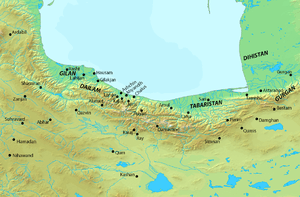Semnani people
The Semnani people (Semnani: سمنی مرتمونی, samani mertimüni) are a Caspian people,[1] part of the greater Iranian people who primarily live in northern Iran and speak the Semnani language. Today, the majority of Semnanis speak Persian.
| Total population | |
|---|---|
| c. 300,000 | |
| Regions with significant populations | |
| Northern Iran | |
| Languages | |
| Semnani (indigenous), Persian (national) | |
| Religion | |
| Shi'a Islam | |
| Related ethnic groups | |
| Iranian peoples, Caspians |


Throughout the Medieval era, the Semnani people were ruled by various dynasties from Tabaristan. For much of the Pre-Islamic era, the Semnani people were part of the territory of Parthia. Ever since the Seleucid era, the land became known as Comisene, the indigenous name for the province, which survives in the Semnani language as kömeshi.
Origins
The Semnani people are Caspians who migrated to the northern fringe of the central Iranian plateau from the southern shores of the Caspian Sea. It is not known when this migration occurred, but these Caspian-speaking tribes slowly intermixed with the tribes of the plateau, creating what has been dubbed in Persian literature as an "Isle of Dialects."[2] These same Caspian migrants also settled in the villages and towns of Biyabunak, Eyvanakey, Sorkheh, Garmsar, Shahmirzad, Darjezin, and Mehdishahr. The city of Semnan is the primary hub of the Semnani people, though it is unclear whether the name itself came from the people or the settlement.
Cultural Identity

Like many cultures of the Middle East, Semnani people emphasize kindness, compassion, and hospitality.[3] The identity of the Semnani people is deeply intertwined with their language. The ardent desire to preserve their unique identity manifests throughout Semnani poetry.
|
سمنی زفون هما تاریخه Semnani is our history
|
The spread of Persian—and even English—has threatened the preservation of the Semnani language. Poets, like Azim Hajj Ramazani, offer both hope and warning to the Semnani people.
|
زفونی دار هنی سوز ا زند، ای دد O Brother! The Tree of our Language is still alive and green.
|
Agriculture
The arid plains of Iran's central desert sharply contrast with the lush, forested north of Iran, but the lack of rain did not stop the Semnani people from settling the alluvial fans and bringing the desert to life for the last thousand years.[4]
.jpg)
The Semnani people built complex water irrigation projects to siphon snowmelt and runoff from the mountains.[5] One such project is Parö, which in Semnani means the water splitter. A large channel made of stonemasonry would draw the rushing water into the city. Several large steps and ponds would reduce the speed of the runoff until the water becomes nearly stationary by the last step. From there, the water would be divided into as many channels as needed and dispatched via a system of overland and subterranean aqueducts. In pre-modern times, an engarnevis would oversee the water distribution process, keeping records of how much water has been dispatched to a particular neighborhood or agricultural district.
References
- Memarian, Rahim (2012). نصاب واژگان سمنانی سرودۀ محمد باقر نیری و فرهنگ شکوهی (in Persian). Semnan: Hableh Rud. ISBN 978-600-5764-29-1.
- Memarian, Rahim (2012). نصاب واژگان سمنانی سرودۀ محمد باقر نیری و فرهنگ شکوهی (in Persian). Semnan: Hableh Rud. ISBN 978-600-5764-29-1.
- "پاسداشت هویت مردم سمنان بعنوان صاحبان دار المرحمه".
- "قدمت 1000 ساله تقسیم آب در سمنان".
- "آب پخش کن سمنان".